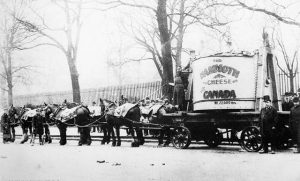Big Cheese Stories
Jason Allard, Hudson Bay Company clerk, and James W. Robertson, Canadian Dairy Commissioner, contributed to some of the folklore that surrounds “big cheese”.
Allard’s Cheese
Jason Allard (1848-1931) was born at Fort Langley, BC, the son of Ovid Allard and Justine Cowichan, the sister of a Cowichan confederacy chief T’Soshia. His biographer, Bruce McKelvie, described him as a fur-trader, prince and gentleman(1). As an apprentice clerk for the Hudson Bay Company in the 1860s he had the job of placing food orders; and on one famous occasion, he ordered 200 pounds of cheese for Fort Colville, Washington. An extra “0” crept into the order and in a couple of months, a ton of cheese (2000 pounds) arrived at the fort, to the great surprise of both Allard and his boss, Angus Macdonald. The boss was “wrathy” and Allard had to find a place to hide the cheese. In a storeroom on the post he found a few empty rum barrels and he had the cheese unpacked and repacked into the barrels. Then he hid the barrels under sacking out of Macdonald’s sight. When Macdonald next requested cheese, Allard brought forth his hidden treasure which had absorbed some of the rum flavour from the barrels. It proved to be very popular with the U.S. Army barracks who reportedly travelled up to 100 miles to buy it. When “Allard’s Cheese” finally ran out, everyone was disappointed (2).
The Mammoth Cheese
The second big cheese story is the Mammoth Cheese, made in Perth, Ontario, to celebrate the 1893 Chicago World’s Fair. James Wilson Robertson (1857-1930) was a Scot who immigrated to Canada (3). He and Sir William Macdonald were responsible for the introduction of manual training and home economics into the Canadian school system.
His story began with the Dominion Experimental Farm at Perth, Ontario. Someone decided it would be original to make a huge cheese for the 1893 Chicago World’s Fair. Robertson as an experienced cheesemaker and instructor in dairying was instrumental in sourcing the quantities of milk needed to make a 9,900 kilogram (22,000 pound) mammoth.
The Mammoth made it to the Fair and back again, and was eventually bought by a British tea magnate (who didn’t find it very tasty). A piece has been preserved at the Perth, Ontario Museum, where there is also a six-foot high replica of the Mammoth (4).
An Ontario poet of the times wrote an ode to the Mammoth cheese, which has achieved fame as the worst poem ever written about agriculture (5).
While Robertson catapulted his cheesemaking abilities into becoming Canada’s Dairy Commissioner, Allard became better known for his diplomatic and leadership skills.
References:
(1) B. A. McKelvie, “Jason Allard: fur-trader, prince, and gentleman,” BC Historical Quarterly, IX (1945), 243–57.
(2) Nancy Marguerite Anderson. http://furtradefamilyhistory.blogspot.ca/
(3) ROBERTSON, JAMES WILSON. http://www.biographi.ca/en/bio/robertson_james_wilson_15E.html
(4) Mammoth Cheese replica. https://www.atlasobscura.com/places/mammoth-cheese-replicas
(5) Canadian Giants. Giant Cheeses. https://www.collectionscanada.gc.ca/cool/002027-2402-e.html
*”Big cheese” is an idiom that comes from Urdu , in which chiza means “a thing” according to Dictionary.com. Down the line the phrase “the real chiz” came to mean “a big thing or event.” This changed over time into big cheese. (thanks Sandra for asking the question). https://www.vocabulary.com/dictionary/big%20cheese

